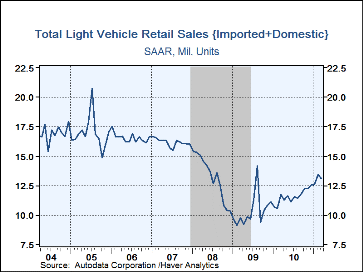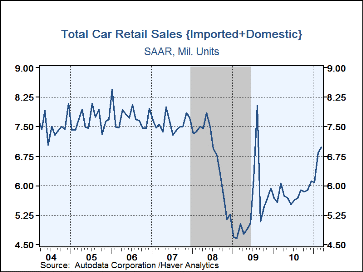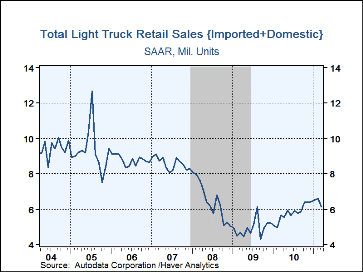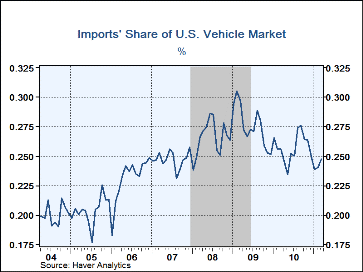 Global| Apr 04 2011
Global| Apr 04 2011U.S. Vehicle Sales Drop With Higher Gasoline Prices
by:Tom Moeller
|in:Economy in Brief
Summary
Gasoline prices can have an impact on demand for motor vehicles. And when gas prices surge as they have, demand goes down, and demand for less fuel efficient light-trucks goes down a lot. Unit sales of light vehicles fell 4.2% during [...]
Gasoline prices can have an impact on demand for motor vehicles. And when gas prices surge as they have, demand goes down, and demand for less fuel efficient light-trucks goes down a lot. Unit sales of light vehicles fell 4.2% during March to 13.11M units (SAAR). The decline reversed most of February's gain. Consensus estimated sales of 13.4M, according to the Bloomberg survey. (Seasonal adjustment of these figures is provided by the U.S. Bureau of Economic Analysis.) The overall decline left sales up 11.8% versus last year.
Sales of less fuel efficient light trucks indeed showed the most weakness and fell 7.0% m/m to 6.14M, the lowest level since September. Domestic model sales fell 7.6% to 5.10M while imports fell 4.2% to 1.05M. Conversely, sales of autos rose 2.1% to 6.97M. It was the highest level since sales incentives spiked demand in August 2009. Imported car sales rose 2.8% to 2.20M and sales of domestics rose 1.7% to 4.77M.
Imports' share of the U.S. light vehicle market rose to 24.7%. (Imported vehicles are those produced outside the United States.) Imports' share of the U.S. car market ticked up to 31.5% versus the record 35.0% for all of 2010. Imports' share of the light truck market rose to 17.0% but remained down from the record 19.7% in 2009.
The U.S. vehicle sales figures can be found in Haver's USECON database.
Bubbles and Unemployment from the Federal Reserve Bank of Minneapolis can be found here.
| Light Vehicle Sales (SAAR, Mil. Units) | Mar | Feb | Jan | Y/Y | 2010 | 2009 | 2008 |
|---|---|---|---|---|---|---|---|
| Total | 13.11 | 13.44 | 12.62 | 11.8% | 11.58 | 10.38 | 13.22 |
| Autos | 6.97 | 6.83 | 6.09 | 15.0 | 5.78 | 5.45 | 6.76 |
| Domestic | 4.77 | 4.69 | 4.12 | 16.5 | 3.78 | 3.56 | 4.44 |
| Imported | 2.20 | 2.14 | 1.97 | 11.9 | 2.02 | 1.89 | 2.32 |
| Light Trucks | 6.14 | 6.61 | 6.53 | 8.3 | 5.80 | 4.93 | 6.46 |
| Domestic | 5.10 | 5.51 | 5.49 | 10.0 | 4.84 | 3.96 | 5.28 |
| Imported | 1.05 | 1.09 | 1.04 | 0.7 | 0.96 | 0.97 | 1.18 |
Tom Moeller
AuthorMore in Author Profile »Prior to joining Haver Analytics in 2000, Mr. Moeller worked as the Economist at Chancellor Capital Management from 1985 to 1999. There, he developed comprehensive economic forecasts and interpreted economic data for equity and fixed income portfolio managers. Also at Chancellor, Mr. Moeller worked as an equity analyst and was responsible for researching and rating companies in the economically sensitive automobile and housing industries for investment in Chancellor’s equity portfolio. Prior to joining Chancellor, Mr. Moeller was an Economist at Citibank from 1979 to 1984. He also analyzed pricing behavior in the metals industry for the Council on Wage and Price Stability in Washington, D.C. In 1999, Mr. Moeller received the award for most accurate forecast from the Forecasters' Club of New York. From 1990 to 1992 he was President of the New York Association for Business Economists. Mr. Moeller earned an M.B.A. in Finance from Fordham University, where he graduated in 1987. He holds a Bachelor of Arts in Economics from George Washington University.










